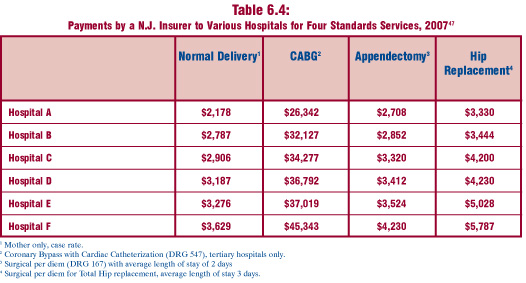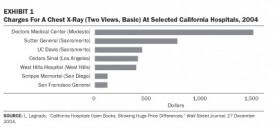

What Works
This comparison is a fairly straightforward examination of the relative merits of tables vs. charts. Both of these images are trying to help explain the tricky business of health care pricing. The bar graph comes from an article in Health Affairs by Uwe Reinhardt that starts by taking a look at the cost of a single procedure across hospitals within a small sample of hospitals in the state of California. The table does the same sort of thing but it was written by the New Jersey Commission on Rationalizing Health Care Resources so it looks at hospitals in New Jersey. It also looks across a number of treatments, not just one.
Each of these presentation styles has its merits. The graph is an instantly legible message: the cost of a chest X-ray varies a lot from one hospital to the next. The table doesn’t have the same instant legibility but it provides much more detail across a range of treatments, demonstrating that the pattern of discrepant charges is not restricted to a single treatment. Further, the table demonstrates a pattern – the relative cost of hospital treatments is fairly stable. If a hospital charges at the low end for one treatment, it probably charges at the low end for all treatments.
What Needs Work
The bar graph does a good job of providing instant legibility but it doesn’t give much detail. It works in the introduction of the paper to orient the reader but would not be nearly as useful in the results section because it shows only one treatment.
The table provides a lot of detail, but unless someone is already deeply interested in the problem of health care costs, they may not take the time to read it. No patterns are immediately obvious – it’s just a boxy sea of numbers. The presentation of the table as a graphic does little to help the eye. At least the columns are arranged from lowest payment to the greatest payment. They might have been made more visually legible if the font increased or the boxes got progressively darker as payment values increased down the columns.
Relevant Links
Chaos Behind a Veil of Secrecy in Health Affairs by Uwe E. Reinhardt
“How Do Hospitals Get Paid – A Primer” on Nytimes.com Economix blog by Uwe E. Reinhardt
New Jersey Commission on Rationalizing Health Care Resources, Final Report 2008 by the State of New Jersey Department of Health and Senior Services
